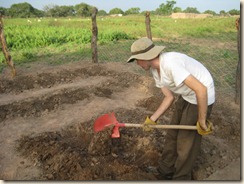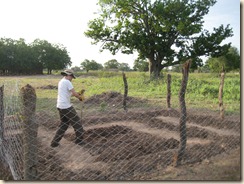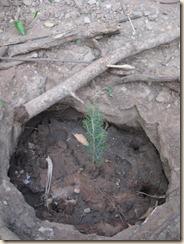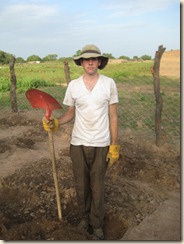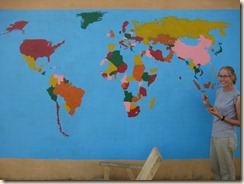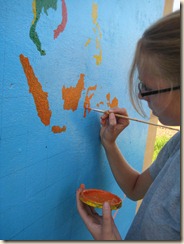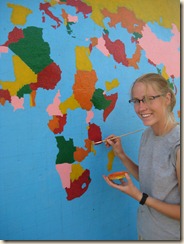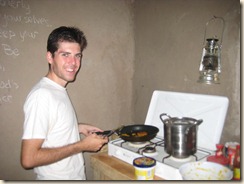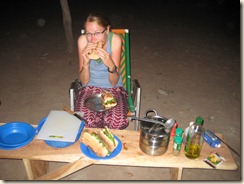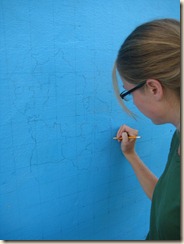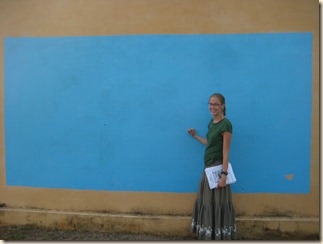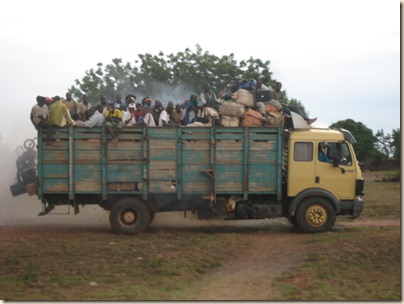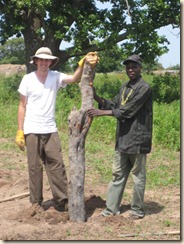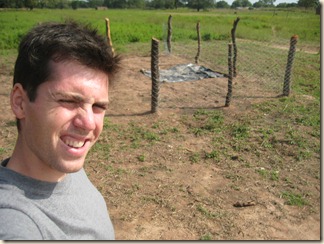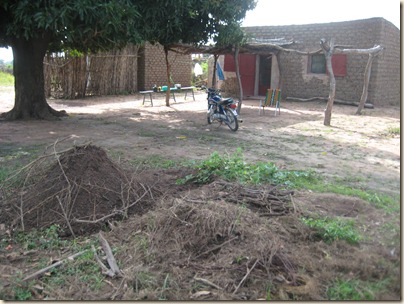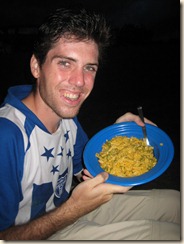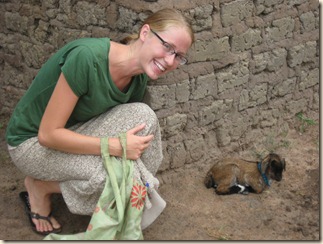I’m sure you all are busy with Thanksgiving preparations at the moment, so in the spirit of this great American holiday, we thought we’d share a little bit more about Malian delicacies.
Everyday, we cook our own breakfast and dinner (for our own personal sanity and health). But we do eat lunch with a “host family” aka our next door neighbors every day. Now, when we sit down to lunch with our host family, we now know to expect the following: 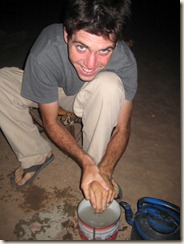
First, we will be passed an large old tomato paste can filled with water and (only due to our insistence) a bar of soap to wash our hands. Next, our “host mom” will place 2 large covered bowls on a stool or the ground, 1 bowl for sauce and 1 for toh (see description below), rice, or couscous. We recently realized that our host mom has figured out that we prefer pretty much anything to toh, because of the inaudible disappointed sigh which escapes us every time she removes the cover to reveal toh underneath. After combining the 2 ingredients, we eat together out of 1 bowl, and only with our right hand (since they use the left hand to clean themselves after going to the bathroom). Sauce is usually plentiful, but meat and veggies are expensive; therefore, a few pieces are placed in the center of the bowl and everyone gets a bite or two. Though its communal eating, everyone keeps to the food directly in front of them and it is considered rude to reach across and eat out of the other side of the bowl. Malians generally do not talk over meals, but simply eat their fill, wash their hands in that same tomato paste can, give thanks to God, back their chair away from the food and wait for everyone to finish eating before starting up more conversation. The last person eating always leaves a bit of food in the bowl to show the host that they didn’t leave hungry. But no matter how much you eat, as a guest, Malians are NEVER convinced that you ate enough! Therefore, the only polite way to turn down food is to very very firmly state that you are so full that if you eat any more food you will explode.
Eating some papaya for desert. We only had to bike 40 kilometers round trip to get it from a neighboring town since its not in season yet!
But WHAT exactly are we eating every day? Well, every malian dish has a base of carbohydrates. This usually is toh, which we’ve described as a cross between playdoh, mash potatoes, and a sponge. It is made out of millet, sorghum, or corn (in ascending order of taste). Rice is more expensive and therefore less common, and occasionally, we eat homemade millet, sorghum, or corn couscous. However, no matter the base, what really sets one meal apart from another is the sauce.
Here are some examples of some classic Malian dishes (keep in mind, food in every region of Mali is different!)
1.) Toh and green okra sauce: Malians love their okra. There are some families who literally eat this 3 meals a day almost every day of the week. Now, If you’ve ever eaten okra, you may be familiar with the slimy muscus-like texture if retains after it has been cooked. The taste is fine but it was a little bit of a challenge to get over the texture of this dish. However, about 4 months in to Peace Corps service, we’ve finally gotten used to this and are startled to find our selves even enjoying it from time to time.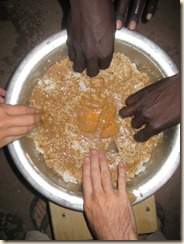
2.) Rice and Tigedegena: This is one of my favorite dishes. Tigedegena is a spicy malian peanut butter sauce cooked with tomatoes, dried fish (remember landlocked country), and hot peppers. In Short, it is delicious and probably one of the few foods I’ll really miss when I leave Mali.
3.) Zame (zah-may): For special occasions, we have the Malian equivalent of Ris au Gras. This is rice dripping in oil, spices, and mixed with hot peppers. We ate quite a bit of this for Tabaski (the muslim thanksgiving) along with lamb or goat meat and a few vegetables.
4.) Toh and Onion Fish Sauce with Leaf Sauce: think vegetable soup broth minus most of the veggies with a few dried fish (heads included). Not bad tasting at all, its just hard to convince people, that if everyone gets a tablespoon of eggplant, that this is NOT a complete serving of vegetables. Its also hard to explain why Americans don’t like fish heads (or goat intestine, etc) Directly before eating, the fish sauce is poured into the leaf sauce bowl and the toh is dipped into mixed sauces. This means you REALLY need to make sure everyone washed their hands with soap before dinner!
5.) Monni/Siri : Millet, sorghum or corn powder + powdered milk + a little sugar + water =malian breakfast porridge. We don’t eat this as much any more since we make breakfast for ourselves every morning. It tastes fine, its just not very nutritious. So one of my side projects is to have conversations with people about adding peanut powder to give some much needed protein to their kids who show severe signs of malnutrition.
So in summation, while we enjoy Malian food for 1 meal a day, we have decided to cook dinners for ourselves in order to get enough vegetables, protein, and variety to keep us happy and healthy. We’re also looking forward to our own American Thanksgiving feast with other volunteers. We hope you all have a wonderful Thanksgiving.
~Joye (and Jim)

